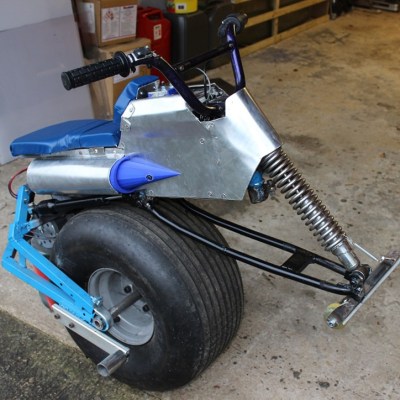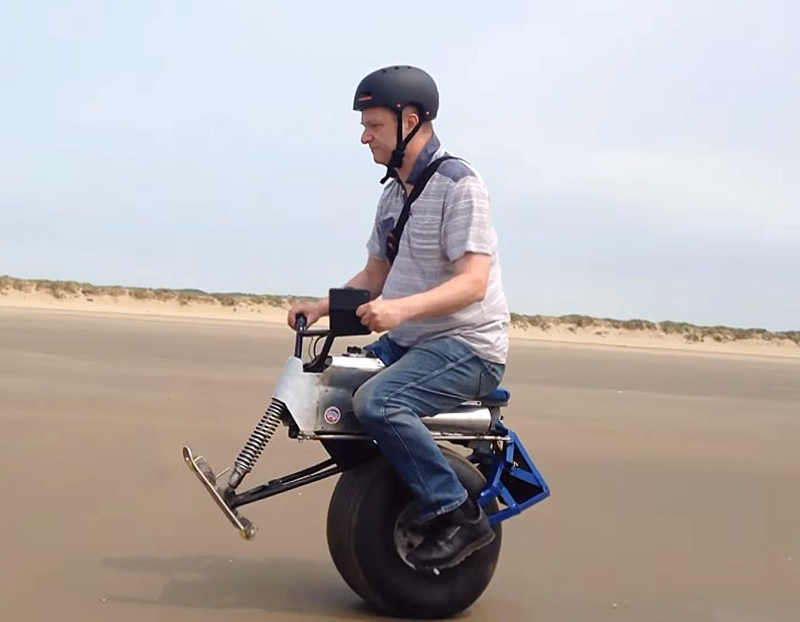[XenonJohn] wrote in to let us know about updates and a recent test drive of an Electric Self-Balancing One-wheeled Motorcycle, fresh from the beach where he says it proved to be great fun to ride. The design and build have been updated since we last saw it as a semifinalist entry in the 2014 Hackaday Prize. The original, he says, “looked cool but was slow, cumbersome and really dangerous to ride.”
 Since then it has been completely redesigned and now has a super fat kite-surfer wheel, a front crash skid with damper, and a variable geometry which allows it to steer properly despite just having one wheel. It does this by allowing the rider to shift their position relative to the wheel, instead of the seat always being rigidly locked directly above the axle.
Since then it has been completely redesigned and now has a super fat kite-surfer wheel, a front crash skid with damper, and a variable geometry which allows it to steer properly despite just having one wheel. It does this by allowing the rider to shift their position relative to the wheel, instead of the seat always being rigidly locked directly above the axle.
That steering is a pretty clever upgrade, but we do wonder if the new crash skid will have an atlatl effect and really launch the rider in a crash. Our gut feeling aside, it is designed not to plant itself in the pavement, but to slide along (without ejecting the rider) until the vehicle loses all momentum.
There is something about self-balancing unicycles that attracts experimenters, each of whom takes a different approach. We see everything from this device constructed mainly from a Razor Scooter to this more polished-looking unit based on an earlier Segway clone design. [XenonJohn] reminds us that “there is still much to learn in this area and you can genuinely innovate even as a hobbyist. Also, you can only do so much on a computer, you then have to actually build something and see how well it works. [This recent test] shows what you can do if you just keep on experimenting.” Video of the test drive is below.
The project’s site has plenty of additional information, as well as a collection of photos of similar machines from around the world including art concepts. [XenonJohn] says that after years of work, he’s finally happy with the current unit and is next going to make it easier for others to build their own. If he decides to have a run at one of the 2016 Hackaday Prize categories, there’s still plenty of time!















Why only one wheel? What are the advantages?
Size?
The technical challenge :)
Ballte Angel Alita “Tuned” equipment?
It still lacks a railgun to be complete. Oh. Wait.
free ride through the air and a face plant when you have to stop fast.
makes you look like a dork
cant get that effect on normal bike, doh!
Rubber will get very, very expensive in the distopian future.
The seatless and electric self-balancing unicycles are lot of fun to ride, especially off-road and up-hill.
You don’t have to pay for two tires!
How about we keep both tires and when we get a flat it can drive on just one to the tire store?
The selfie kit needs an upgrade too… wood ? ;-). How does he turn ?
Sticks his arm out and catches the wind.
Or, he leans.
With the wind in the gif sequence it looked like he was going upwards of 40 mph, I was a tiny bit disappointing by the speed in the video. A rad piece of engineering regardless!
I suspect that even at the relatively low speeds achieved, he felt like he was going 100+. The sensation of speed has to be pretty extreme when you don’t really have any of the machine within your field of view.
Notice the video didn’t show any hard braking.
Yawn. It’s so slow. Wake me up when he implements ludicrous mode. Or better yet, a pulse jet engine.
Appropriate name, sir. If you think you can do better, let’s see it.
I think ‘Wet Blanket’ is jealous. How fast would someone dare to travel on that thing? I’ll stick to a nice 10 Mph on a grassy field!
I think you need to contact Colin Furze if you want someone to build that! I’m sure if anyone could do it he could.
Is he holding the pre-takeoff checklist?
Venus Wars style speeder bikes here we come!
+1 for venus wars
ANUS
https://www.youtube.com/watch?v=y83pv0nb1yI
Boy, if it weren’t for that youtube link, this would be just like every other hackaday comment.
I won’t even ask.
COOL! I love the one that pumps exhaust fumes directly into the riders face! Well thought out design! I bet it’s easy to asphyxiate.on runs over 100 feet.
Recall the PVC and compressed air ‘discussion’ a few days ago, then watch the ANUS video from about the 6 minute mark…
Interesting and challenging hack from a technical perspective. But I can see a problem with it – that is sudden braking = the rider being tossed over the handle bars and doing a nasty face plant. .
Sudden braking on a machine like this should never be a problem (remember it’s only going about 15mph), there are no mechanical brakes and so the wheel never just stops, a couple of mechanisms can be used to slow/stop a mono wheel vehicle such as this,
– With control mechanisms that require the user to disrupt the balance by leaning/pushing on the handle bars (think Segway) all the rider needs to do is stop pushing – if you want to stop in a hurry then you can lean back.
– A slightly more advanced way of stopping a machine like this, if you momentarily speed the unicycle up beyond what is required to balance the rider, it will tip the rider backwards behind the balance point, the unicycle will then stop quite quickly.
The only way you will ever find yourself flying over the handle bars is A) if you suffer some sort of mechanical mishap, or B) if you ride into something unmovable, and I imagine both of these situations would just as easily unmount somebody riding a normal motorcycle.
This isn’t to say such a device is foolproof, but then I fell of my bicycle a couple of times before I finally got the hang of riding it.
i can’t wait till we can all ride atop our little BB-8 droids
Next evolution step of this leads (in)to the jungle of star wars episode 6?
isn’t ford working on a detachable tire that doubles as a self balancing motorized unicycle? Saw that a patent was filed.
Needs a pole on the back extending upwards to make a 3rd person gopro video of the inevitable spectacular and possibly humorous failure.
Does anyone know much power is used just to keep the unit balanced?
reminds me of the racers from Venus Wars
Thanks for the comments. In terms of top speed you are correct in that you are mainly limited by your personal fear. I have face-planted on tarmac (video already on YTube for you to laugh at) with a full crash helmet on and it still hurt a lot. The skid was fitted after that. It tended to stick to tarmac and not actually “skid” at all so now it has 2 small wheels concealed inside. This is what I mean about building and testing repeatedly to see what works. They work fine on tarmac and you do roll to a stop. On sand it probably would still not work very well but at least the landing is softer. The machine is slim when viewed from above with fairly smooth sides, this helps a lot if you bail out and jump off it to one side. The first one had a motorbike fairing which looked good but your legs got tangled up in it if you fell off. The targets at this stage were simply making it easier to ride and getting a decent steering system working. They have been achieved. Braking is easy actually, there is a twist grip on the left handlebar that adjusts the balance angle, you make it lean back to slow down. It also automatically leans back if you exceed 80% of max motor power. The power question is interesting. The battery lasts far longer than I would expect. If you think about it it only has to overcome the rolling resistance of one wheel, plus wind resistance. It also has regenerative braking so even though it accelerates then slows almost imperceptibly at rapid intervals to keep self-balanced, you could argue some of the energy is recovered as it does that. Gradual turns can be done by gentle weight shifting, for tight turns you turn the handlebars and the frame changes shape so you end up running on inside edge of the tyre. The reason for doing it? The challenge of doing something that defies most notions of what is possible of course and the challenge of developing something genuinely original during your lifetime. It is also simply really good fun to ride for a mile or two on it along a deserted beach. Riding it is like sitting on some kind of living animal as it feels more like you are persuading it to do what you want it to do than fully controlling it! In the selfie shot you can see it performing a lot of small movements all on its own independently of my own control inputs. Regarding plans, the welded tube frame has ended up overcomplex and now the whole hardware design needs to be simplified so can be bolted together from laser cut panels or similar.
I watch this and can’t help but think of the “Road Song of the Transport Cadets”…
Haha. Nobody’s posted a certain clip from ‘South Park’ yet!
I think this one-wheeled death-trap is awesome…to watch. I like my 2-4 wheels.
+10. Still better then flying. Lol
All this technical achievement yet I can’t help but laugh at the literal selfie “stick”. ????